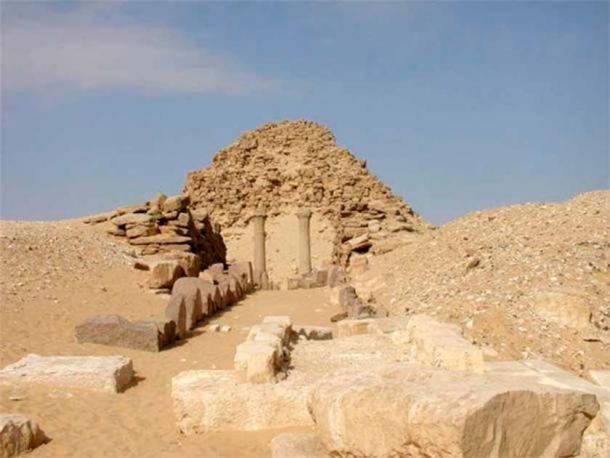Who Is Interred at the Abusir Necropolis, the Egyptian Funerary Jewel?

A lot of what we know about the Ancient Egyptian civilization was discovered through their burials. These ancient people paid special attention to the afterlife, and thus their funerary rituals were quite elaborate and grand. This is especially true for the pharaohs, who built for themselves lavish pyramid tombs and complexes. One of the foremost of the royal necropolises is located at Abusir – The House of Osiris – a vast funeral field near Giza. Who were the pharaohs laid to rest here?
Where Kings Were Laid to Rest – Abusir Necropolis
The Abusir necropolis is an ancient burial ground located in the desert of Egypt, about 15 kilometers (10 mi) south of Giza. This site is home to a large number of pyramids, temples, and tombs that date back to the Old Kingdom period of ancient Egypt, which spanned from 2686 BC to 2181 BC. The site was used for burials of the Pharaohs of the Fifth Dynasty, including Neferefre, Nyuserre Ini, and Sahure.
Abusir, together with necropolises such as Saqqara, Giza, and Dahshur, is a part of the so-called “Pyramid Fields” – a series of ancient Egyptian funerary complexes situated across a thirty kilometer (19 mi) stretch on the Western Desert plateau, close to the ancient capital of Memphis, Lower Egypt, and today in Giza, Egypt.
In 1902, pioneering Egyptologist and Egyptian explorer Ahmed bey Kamal was the first to discover the Abusir necropolis and name it accordingly. However, it was not until the 1970s that the site was properly excavated by a team of Czech archaeologists led by Miroslav Verner. Over the years, the team uncovered several important structures and artifacts that have helped to shed light on the life and culture of ancient Egypt. Ever since, Abusir proved to be one of the most important archeological sites in Egypt.
Pyramids as an Eternal Memorial
The most notable features of the Abusir necropolis are the pyramid complexes that are scattered throughout the site. These awe-inspiring structures were built as tombs for the pharaohs of the Fifth Dynasty, and they were some of the first pyramids to be constructed out of limestone rather than mud brick.

Ruins of Sahure’s pyramid complex at Abusir. (John Bodsworth / Public Domain )
One of the most impressive pyramids at Abusir is the Pyramid of Sahure. As the name suggests, this structure was built for the pharaoh Sahure, who ruled Egypt for roughly 13 years in the early 25th century BC. The pyramid measures approximately 79 meters (259 ft) on each side and is 47 meters (154 ft) high. It is notable for its beautiful reliefs and hieroglyphics, which depict scenes from Sahure’s life and reign. There are around 370 meters (1214 ft) of intricate reliefs at Sahure’s pyramid, compared to just 100 meters (320 ft) in Khufu’s great pyramid.

Pyramid of Neferirkare Kakai. (Aoswch (Axel Seedorff)/CC BY-SA 2.0 DE)
Another important pyramid at Abusir is the Pyramid of Neferirkare Kakai. This structure was built for the pharaoh Neferirkare, who ruled Egypt for a brief period in the mid-25th century BC. The pyramid is the tallest one on the site, and it is notable for its quite unusual design that deviated from the norms of the time. Instead of a traditional pyramid shape, the structure is more like a step pyramid, with several levels of decreasing size. When the pharaoh died, the work was finished by his successors, but was somewhat rushed with cheap materials used.

Pyramid of Nyusserre at Abusir. (Kurohito/CC BY-SA 3.0)
The Pyramid of Pharaoh Nyuserre Ini, the most avid builder of all the Fifth Dynasty rulers, is the best preserved structure in the necropolis. It is also the last tomb for a king built at the site, as his successors were laid to rest elsewhere, notably at Saqqara. Once, the pyramid was grandiose, being some 52 meters tall (170 ft) and made with quality limestone. With the passing ages, however, it has been reduced to a mound of rubble, but even so it produced some very important archaeological finds. It is a great insight into the building practices of the Fifth Dynasty.
Temples and Tombs – All for the Glory of the Ancestors
In addition to the pyramids, the Abusir necropolis is also home to several mastaba burials of high officials from the period. A mastaba is a flat-roofed rectangular structure that was used as a funerary building throughout Ancient Egyptian history. The most notable one at Abusir is the mastaba of Ptahshepses, who was the powerful vizier under Pharaoh Nyuserre. Also present are mastabas of Count Kakaibaef and Prince Nakhtsare.
Finally, the Abusir necropolis is also home to several smaller tombs that were used to bury members of the royal family and other important individuals. These are situated to the south, and contain many burials that predate the Fifth Dynasty, showing use that spanned across centuries. Amongst these tombs, the most important are the tombs of priest Hetepi from the Third Dynasty, the tomb of Vizier Qar from the Sixth Dynasty, or the tomb of Nakhtmin, the royal charioteer under Ramses II, from the Nineteenth Dynasty.
The Enduring Legacy of the Ancients
The Abusir necropolis is a fascinating site that offers a wealth of information about the life and culture of ancient Egypt. From its impressive pyramids and temples to its smaller tombs and structures, the site is a treasure trove of historical artifacts that have helped archaeologists to piece together the story of this ancient civilization. Despite its age and the wear and tear of time, the site remains an important reminder of the ingenuity and creativity of the ancient Egyptians and their enduring legacy.